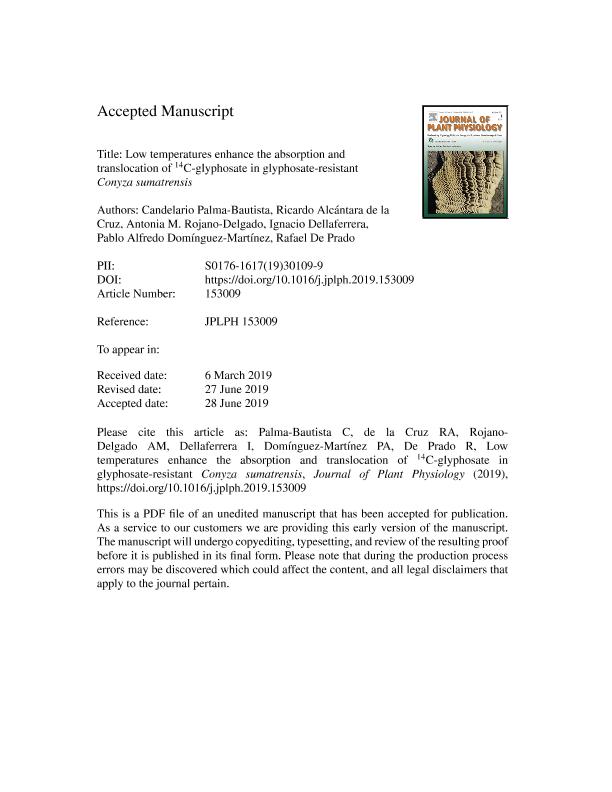Mostrar el registro sencillo del ítem
dc.contributor.author
Palma Bautista, Candelario

dc.contributor.author
Alcántara de la Cruz, Ricardo

dc.contributor.author
Rojano Delgado, Antonia María

dc.contributor.author
Dellaferrera, Ignacio Miguel

dc.contributor.author
Domínguez Martínez, Pablo Alfredo
dc.contributor.author
De Prado, Rafael

dc.date.available
2021-09-02T16:58:16Z
dc.date.issued
2019-09
dc.identifier.citation
Palma Bautista, Candelario; Alcántara de la Cruz, Ricardo; Rojano Delgado, Antonia María; Dellaferrera, Ignacio Miguel; Domínguez Martínez, Pablo Alfredo; et al.; Low temperatures enhance the absorption and translocation of 14C-glyphosate in glyphosate-resistant Conyza sumatrensis; Elsevier Gmbh; Journal of Plant Physiology; 240; 153009; 9-2019; 1-28
dc.identifier.issn
0176-1617
dc.identifier.uri
http://hdl.handle.net/11336/139565
dc.description.abstract
Influence of low temperatures on the glyphosate efficacy was studied in glyphosate-resistant (R) and -susceptible (S) Conyza sumatrensis biotypes.For this purpose, the physiological and enzymatic aspects involved werecharacterized under two growing temperature regimes [high (30/20 oC) andlow 15/5oC temperatures day/night]. The R biotype was 5.5 times moreresistant than the S biotype at high temperatures; however, this R-to-S ratio decreased to 1.6 at low temperatures. At 96 h after treatment (HAT), theshikimic acid accumulation was higher in the S biotype in both temperatureregimes (4.6 and 1.9 more shikimic acid at high and low temperatures,respectively), but the accumulation of the R biotype increased 2.6 times at lowtemperatures compared to high ones. From 24 to 96 HAT, the 14C-glyphosateabsorption ranged from 28 to 65% (percentage reached from 48 HAT) at lowtemperatures and from 20 to 50% at high temperatures (gradual increase), butthere were no differences between C. sumatrensis biotypes within eachtemperature regime. At high temperatures, the 14C-glyphosate translocationwas different between biotypes, where the R one retained at least 10% moreherbicide in the treated leaves than the S biotype at 96 HAT. So, the S biotypetranslocated 40% of 14C-glyphosate absorbed to roots, and the R biotypetranslocated only 28% of herbicide at the same period. At low temperatures,there were no differences between biotypes, and at 96 HAT, the 14C-glyphosate found in treated leaves was ~47% and up to ~42% reached the roots, i.e., the resistance mechanism was suppressed. The basal and enzymaticactivities of the 5-enolpyruvyishikimate 3-phosphate synthase were differentbetween temperature regimes, but there was no differences between biotypeswithin each temperature regime, showing that target-site resistancemechanisms did not contribute in the glyphosate resistance of the R biotype.Low temperatures enhanced the absorption and translocation of glyphosate bysuppressing the resistance mechanisms improving its efficacy on resistantplants. This is the first characterization about the role of temperatures in theglyphosate efficacy on C. sumatrensis.
dc.format
application/pdf
dc.language.iso
eng
dc.publisher
Elsevier Gmbh

dc.rights
info:eu-repo/semantics/openAccess
dc.rights.uri
https://creativecommons.org/licenses/by-nc-sa/2.5/ar/
dc.subject
5-ENOLPYRUVYISHIKIMATE 3-PHOSPHATE SYNTHASE
dc.subject
GLYPHOSATE TRANSLOCATION
dc.subject
SUMATRAN FLEABANE
dc.subject
VACUOLAR SEQUESTRATION
dc.subject.classification
Agricultura

dc.subject.classification
Agricultura, Silvicultura y Pesca

dc.subject.classification
CIENCIAS AGRÍCOLAS

dc.title
Low temperatures enhance the absorption and translocation of 14C-glyphosate in glyphosate-resistant Conyza sumatrensis
dc.type
info:eu-repo/semantics/article
dc.type
info:ar-repo/semantics/artículo
dc.type
info:eu-repo/semantics/publishedVersion
dc.date.updated
2020-11-27T18:49:08Z
dc.journal.volume
240
dc.journal.number
153009
dc.journal.pagination
1-28
dc.journal.pais
Alemania

dc.description.fil
Fil: Palma Bautista, Candelario. Universidad de Córdoba; España
dc.description.fil
Fil: Alcántara de la Cruz, Ricardo. Universidade Federal do São Carlos; Brasil
dc.description.fil
Fil: Rojano Delgado, Antonia María. Universidad de Córdoba; España
dc.description.fil
Fil: Dellaferrera, Ignacio Miguel. Consejo Nacional de Investigaciones Cientificas y Tecnicas. Instituto de Ciencias Agropecuarias del Litoral. - Universidad Nacional del Litoral. Instituto de Ciencias Agropecuarias del Litoral.; Argentina. Universidad Nacional del Litoral; Argentina
dc.description.fil
Fil: Domínguez Martínez, Pablo Alfredo. National Institute of Forestry, Agriculture and Livestock Research; México
dc.description.fil
Fil: De Prado, Rafael. Universidad de Córdoba; España
dc.journal.title
Journal of Plant Physiology

dc.relation.alternativeid
info:eu-repo/semantics/altIdentifier/doi/http://dx.doi.org/10.1016/j.jplph.2019.153009
dc.relation.alternativeid
info:eu-repo/semantics/altIdentifier/url/https://www.sciencedirect.com/science/article/abs/pii/S0176161719301099
Archivos asociados
